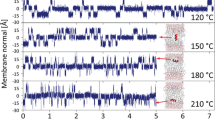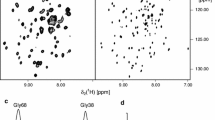Abstract
We study the structural and energetic consequences of (α-helical) amphipathic peptide adsorption onto a lipid membrane and the subsequent formation of a transmembrane peptide pore. Initially, each peptide binds to the membrane surface, with the hydrophobic face of its cylinder-like body inserted into the hydrocarbon core. Pore formation results from subsequent peptide crowding, oligomerization, and eventually reorientation along the membrane normal. We have theoretically analyzed three peptide–membrane association states: interfacially-adsorbed monomeric and dimeric peptides, and the multi-peptide transmembrane pore state. Our molecular-level model for the lipid bilayer is based on a combination of detailed chain packing theory and a phenomenological description of the headgroup region. We show that the membrane perturbation free energy depends critically on peptide orientation: in the transmembrane pore state the lipid perturbation energy, per peptide, is smaller than in the adsorbed state. This suggests that the gain in conformational freedom of the lipid chains is a central driving force for pore formation. We also find a weak, lipid-mediated, gain in membrane perturbation free energy upon dimerization of interfacially-adsorbed peptides. Although the results pertain mainly to weakly-charged peptides, they reveal general properties of the interaction of amphipathic peptides with lipid membranes.






Similar content being viewed by others
References
Bak M, Bywater RP, Hohwy M, Thomsen JK, Adelhorst K, Jakobsen H, Sorensen OW, Nielsen NC (2001) Conformation of alamethicin in oriented phospholipid bilayers determined by (15)N solid-state nuclear magnetic resonance. Biophys J 81:1684–1698
Balgavý P, Dubničková M, Kučerka N, Kieslev MA, Yaradaikin S, Uhríková D (2001) Bilayer thickness and lipid interface area in unilamellar extruded 1,2-diacylphosphatidylcholine liposomes: a small-angle neutron scattering study. Biochim Biophys Acta 1512:40–52
Bechinger B (1999) The structure, dynamics and orientation of antimicrobial peptides in membranes by multidimensional solid-state NMR spectroscopy. Biochim Biophys Acta 1462:157–183
Ben-Shaul A, Gelbart WM (1994) Statistical thermodynamics of amphiphile self-assembly: structure and phase transitions in micellar solutions. In: Gelbart WM, Ben-Shaul A, Roux D (eds) Micelles, membranes, microemulsions and monolayers. Springer, New York, Ch1, pp 359–402
Cantor RS (2002) Size distribution of barrel-stave aggregates of membrane peptides: Influence of the bilayer lateral pressure profile. Biophys J 82:2520–2525
Chen L, Bassolino D, Stouch T (1997) Transmembrane helix structure, dynamics, and interactions: Multi-nanosecond molecular dynamics simulation. Biophys J 73:3–20
Dan N, Safran SA (1998) Effect of lipid characteristics on the structure of transmembrane proteins. Biophys J 75:1410–1414
Dempsey CE, Ueno S, Avison MB (2003) Enhanced membrane permeabilization and antibacterial activity of a disulfide-dimerized magainin analogue. Biochemistry 42:402–409
Douliez JP, Léonard A, Dufourc EJ (1995) Restatement of order parameters in biomembtanes: calculation of C-C bond order parameters from C–D quadrupolar splittings. Biophys J 68:1727–1739
Fattal DR, Ben-Shaul A (1993) A molecular model for lipid protein interaction in membranes: the role of hydrophobic mismatch. Biophys J 65:1795–1809
Fattal DR, Andelman D, Ben-Shaul A (1995) The vesicle-micelle transition in mixed lipid-surfactant systems: a molecular model. Langmuir 11:1154–1161
Hamm M, Kozlov MM (2000) Elastic energy of tilt and bending of fluid membranes. Eur Phys J B 3:323–335
He K, Ludtke SJ, Heller WT, Huang HW (1996) Mechanism of alamethicin insertion into lipid bilayers. Biophys J 71:2669–2679
Helfrich W (1973) Elastic properties of lipid bilayers: theory and possible experiments. Z Naturforsch 28:693–703
Heller WT, He K, Ludtke SJ, Harroun TA, Huang HW (1997) Effect of changing the size of lipid headgroup on peptide insertion into membranes. Biophys J 73:239–244
Hristova K, Wimley WC, Mishra VK, Anantharamiah GM, Segrest JP, White SH (1999) An amphipathic α-helix at the membrane interface: A structural study using a novel X-ray diffraction method. J Mol Biol 290:99–117
Hristova K, Dempsey CE, White SH (2001) Structure, location, and lipid perturbations of melittin at the membrane interface. Biophys J 80:801–811
Huang HW, Wu Y (1991) Lipid-alamethicin interactions influence alamethicin orientation. Biophys J 60:1079–1087
Huang HW, Chen FY, Lee MT (2004) Molecular mechanism of peptide-induced pores in membranes. Phys Rev Lett 92:198304
Israelachvili JN (1992) Intermolecular and surface forces, 2nd edn. Academic, New York
Kessel A, Ben-Tal N, May S (2001) Interactions of cholesterol with lipid bilayers: The preferred configuration and fluctuations. Biophys J 81:643–658
Koenig BW, Ferretti JA, Gawrisch K (1999) Site-specific deuterium order parameters and membrane-bound behavior of a peptide fragment from the intracellular domain of HIV-1 gp41. Biochemistry 38:6327–6334
Lin J, Baumgaertner A (2000) Stability of a melittin pore in a lipid bilayer: a molecular dynamics study. Biophys J 78:1714–1724
Ludtke SJ, He K, Wu Y, Huang HW (1994) Cooperative membrane insertion of magainin correlated with its cytolytic activity. Biochim Biophys Acta 1190:181–184
Ludtke SJ, He K, Huang HW (1995) Membrane thinning caused by magainin 2. Biochemistry 34:16764–16769
Ludtke SJ, He K, Heller WT, Harroun TA, Yang L, Huang HW (1996) Membrane pores induced by magainin. Biochemistry 35:13723–13728
Matsuzaki K, Sugishita K, Fujii N, Miyajima K (1995) Molecular basis of membrane selectivity of an antimicrobial peptide, magainin 2. Biochemistry 34:3423–3429
Matsuzaki K, Sugishita K, Ishibe N, Ueha M, Nakata S, Miyajima K, Epand RM (1998) Relationship of membrane curvature to the formation of pores by magainin 2. Biochemistry 37:11856–11863
May S (2000) Protein-induced bilayer deformations: The lipid tilt degree of freedom. Eur Biophys J 29:17–28
May S (2002) Membrane perturbations induced by integral proteins: role of conformational restrictions of the lipid chains. Langmuir 18:6356–6364
May S, Ben-Shaul A (1999) Molecular theory of lipid-protein interaction and the Lα−L II transition. Biophys J 76:751–767
May S, Ben-Shaul A (2000) A molecular model for lipid-mediated interaction between proteins in membranes. Phys Chem Chem Phys 2:4494–4502
Münster C, Lu J, Schinzel S, Bechinger B, Salditt T (2000) Grazing incidence x-ray diffraction of highly aligned phospholipid membranes containing the antimicrobial peptide magainin 2. Eur Biophys J Biophys Lett 28:683–688
Münster C, Spaar A, Bechinger B, Salditt T (2002) Magainin 2 in phospholipid bilayers: peptide orientation and lipid chain ordering studied by x-ray diffraction. Biochim biophys Acta 1562:37–44
Oren Z, Shai Y (1998) Mode of action of linear amphipathic alpha-helical antimicrobial peptides. Biopolymers 47:451–463
Rapaport D, Shai Y (1991) Interaction of fluorescently labeled pardaxin and its analogues with lipid bilayers. J Biol Chem 266:23769–23775
Rapaport D, Shai Y (1992) Aggregation and organization of pardaxin in phospholipid membranes. A fluorescence energy transfer study. J Biol Chem 267:6502–6509
Rapaport D, Peled R, Nir S, Shai Y (1996) Reversible surface aggregation in pore formation by paradaxin. Biophys J 70:2502–2512
Ren J, Lew S, Wang Z, London E (1999) Control of the transmembrane orientation and interhelical interactions within membranes by hydrophobic helix length. Biochemistry 38:5905–5912
Sansom MSP (1993) Alamethicin and related peptaibols-model ion channels. Eur Biophys J 22:105–124
Schwarz G, Stankowski S, Rizzo V (1986) Thermodynamic analysis of incorporation and aggregation in a membrane: application to the pore-forming peptide alamethicin. Biochim Biophys Acta 861:141–151
Shepherd CM, Vogel HJ, Tieleman DP (2003) Interactions of the designed antimicrobial peptide MB21 and truncated dermaseptin S3 with lipid bilayers: molecular-dynamics simulations. Biochem J 370:233–243
Smith R, Separovic F, Milne TJ, Whittaker A, Bennett FM, Cornell BA, Makriyannis A (1994) Structure and orientation of the pore-forming peptide, melittin, in lipid bilayers. J Mol Biol 241:456–466
Takei J, Remenyi A, Dempsey CE (1999) Generalized bilayer perturbation from peptide helix dimerization at membrane surfaces: vesicle lysis induced by disulphide-dimerised melittin analogues. FEBS Lett 442:11–14
Yang L, Weiss TM, Lehrer RI, Huang HW (2000) Crystallization of antimicrobial pores in membranes: magainin and protegrin. Biophys J 79:2002–2009
Yang L, Harroun TA, Weiss TM, Ding L, Huang HW (2001) Barrel-Stave model or Toroidal model? A case study on melittin pores. Biophys J 81:1475–1485
Zemel A, Fattal DR, Ben-Shaul A (2003) Energetics and self-assembly of amphipathic peptide pores in lipid membranes. Biophys J 84:2242–2255
Zemel A, Ben-Shaul A, May S (2004) Membrane perturbation induced by interfacially adsorbed peptides. Biophys J 86:3607–3619
Zuckermann MJ, Heimburg T (2001) Insertion and pore formation driven by adsorption of proteins onto lipid bilayer membrane-water interfaces. Biophys J 81:2458–2472
Acknowledgments
A.Z. thanks the Yeshaya Horowitz Foundation for a doctoral fellowship. S.M. thanks the Thüringer Ministerium für Wissenschaft, Forschung und Kunst. The financial support of the Israel Science Foundation (grant 227/02) and the United States-Israel Binational Science Foundation (grant 2002-75) is gratefully acknowledged. The Fritz Haber Center is supported by the Minerva Foundation, Munich, Germany.
Author information
Authors and Affiliations
Corresponding author
Rights and permissions
About this article
Cite this article
Zemel, A., Ben-Shaul, A. & May, S. Perturbation of a lipid membrane by amphipathic peptides and its role in pore formation. Eur Biophys J 34, 230–242 (2005). https://doi.org/10.1007/s00249-004-0445-9
Received:
Accepted:
Published:
Issue Date:
DOI: https://doi.org/10.1007/s00249-004-0445-9




